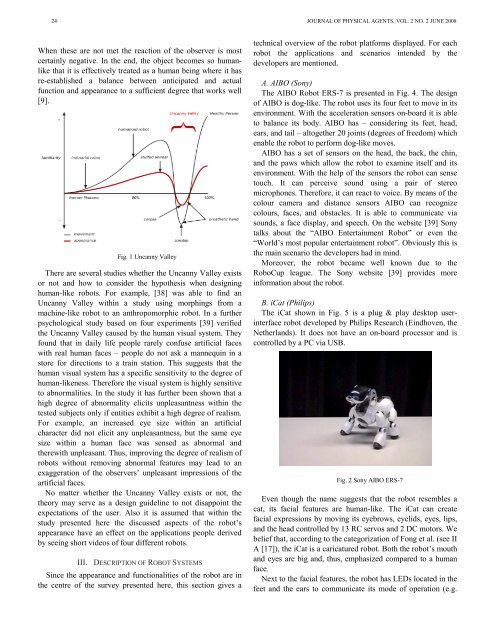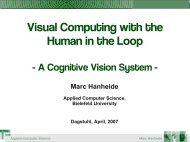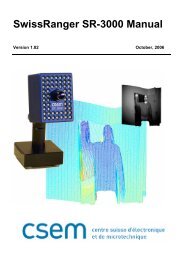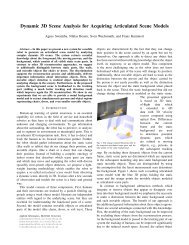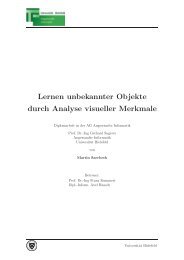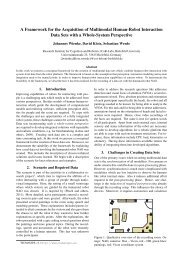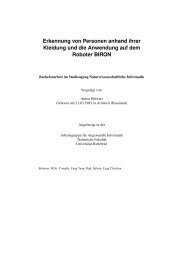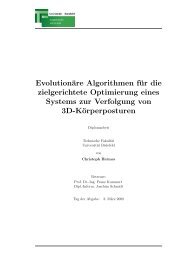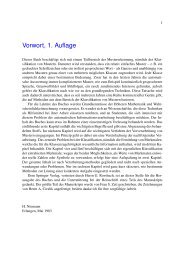Domestic Applications for Social Robots - Journal of Physical Agents
Domestic Applications for Social Robots - Journal of Physical Agents
Domestic Applications for Social Robots - Journal of Physical Agents
You also want an ePaper? Increase the reach of your titles
YUMPU automatically turns print PDFs into web optimized ePapers that Google loves.
24 JOURNAL OF PHYSICAL AGENTS, VOL. 2 NO. 2 JUNE 2008<br />
When these are not met the reaction <strong>of</strong> the observer is most<br />
certainly negative. In the end, the object becomes so humanlike<br />
that it is effectively treated as a human being where it has<br />
re-established a balance between anticipated and actual<br />
function and appearance to a sufficient degree that works well<br />
[9].<br />
Fig. 1 Uncanny Valley<br />
There are several studies whether the Uncanny Valley exists<br />
or not and how to consider the hypothesis when designing<br />
human-like robots. For example, [38] was able to find an<br />
Uncanny Valley within a study using morphings from a<br />
machine-like robot to an anthropomorphic robot. In a further<br />
psychological study based on four experiments [39] verified<br />
the Uncanny Valley caused by the human visual system. They<br />
found that in daily life people rarely confuse artificial faces<br />
with real human faces – people do not ask a mannequin in a<br />
store <strong>for</strong> directions to a train station. This suggests that the<br />
human visual system has a specific sensitivity to the degree <strong>of</strong><br />
human-likeness. There<strong>for</strong>e the visual system is highly sensitive<br />
to abnormalities. In the study it has further been shown that a<br />
high degree <strong>of</strong> abnormality elicits unpleasantness within the<br />
tested subjects only if entities exhibit a high degree <strong>of</strong> realism.<br />
For example, an increased eye size within an artificial<br />
character did not elicit any unpleasantness, but the same eye<br />
size within a human face was sensed as abnormal and<br />
therewith unpleasant. Thus, improving the degree <strong>of</strong> realism <strong>of</strong><br />
robots without removing abnormal features may lead to an<br />
exaggeration <strong>of</strong> the observers’ unpleasant impressions <strong>of</strong> the<br />
artificial faces.<br />
No matter whether the Uncanny Valley exists or not, the<br />
theory may serve as a design guideline to not disappoint the<br />
expectations <strong>of</strong> the user. Also it is assumed that within the<br />
study presented here the discussed aspects <strong>of</strong> the robot’s<br />
appearance have an effect on the applications people derived<br />
by seeing short videos <strong>of</strong> four different robots.<br />
III. DESCRIPTION OF ROBOT SYSTEMS<br />
Since the appearance and functionalities <strong>of</strong> the robot are in<br />
the centre <strong>of</strong> the survey presented here, this section gives a<br />
technical overview <strong>of</strong> the robot plat<strong>for</strong>ms displayed. For each<br />
robot the applications and scenarios intended by the<br />
developers are mentioned.<br />
A. AIBO (Sony)<br />
The AIBO Robot ERS-7 is presented in Fig. 4. The design<br />
<strong>of</strong> AIBO is dog-like. The robot uses its four feet to move in its<br />
environment. With the acceleration sensors on-board it is able<br />
to balance its body. AIBO has – considering its feet, head,<br />
ears, and tail – altogether 20 joints (degrees <strong>of</strong> freedom) which<br />
enable the robot to per<strong>for</strong>m dog-like moves.<br />
AIBO has a set <strong>of</strong> sensors on the head, the back, the chin,<br />
and the paws which allow the robot to examine itself and its<br />
environment. With the help <strong>of</strong> the sensors the robot can sense<br />
touch. It can perceive sound using a pair <strong>of</strong> stereo<br />
microphones. There<strong>for</strong>e, it can react to voice. By means <strong>of</strong> the<br />
colour camera and distance sensors AIBO can recognize<br />
colours, faces, and obstacles. It is able to communicate via<br />
sounds, a face display, and speech. On the website [39] Sony<br />
talks about the “AIBO Entertainment Robot” or even the<br />
“World’s most popular entertainment robot”. Obviously this is<br />
the main scenario the developers had in mind.<br />
Moreover, the robot became well known due to the<br />
RoboCup league. The Sony website [39] provides more<br />
in<strong>for</strong>mation about the robot.<br />
B. iCat (Philips)<br />
The iCat shown in Fig. 5 is a plug & play desktop userinterface<br />
robot developed by Philips Research (Eindhoven, the<br />
Netherlands). It does not have an on-board processor and is<br />
controlled by a PC via USB.<br />
Fig. 2 Sony AIBO ERS-7<br />
Even though the name suggests that the robot resembles a<br />
cat, its facial features are human-like. The iCat can create<br />
facial expressions by moving its eyebrows, eyelids, eyes, lips,<br />
and the head controlled by 13 RC servos and 2 DC motors. We<br />
belief that, according to the categorization <strong>of</strong> Fong et al. (see II<br />
A [17]), the iCat is a caricatured robot. Both the robot’s mouth<br />
and eyes are big and, thus, emphasized compared to a human<br />
face.<br />
Next to the facial features, the robot has LEDs located in the<br />
feet and the ears to communicate its mode <strong>of</strong> operation (e.g.


